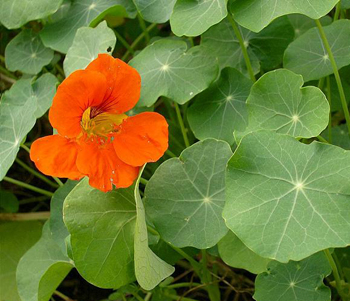Contents:
Common Names | Parts Usually Used | Plant(s) & Culture | Where Found | Medicinal Properties
Legends, Myths and Stories | Uses | Formulas or Dosages | Nutrient Content | How Sold | Bibliography
Scientific Names

- Tropaeolum majus L.
- Tropaeolaceae
- Nasturtium family
Common Names
- Chin-lien-hua (Chinese name)
- Indian cress
- Large indian cress
Parts Usually Used
Flowers, leaves, seeds
Back to Top
Description of Plant(s) and Culture
Nasturtium is an annual plant 1 foot tall, 2 feet wide; sometimes a variety has a trailing or climbing stem grows 5-10 feet long; bears small, almost round, radially veined leaves. Red, orange, or yellow flowers, larger than the leaves, bloom from June to October. There are single and double flower varieties.
Back to Top
Where Found
Native to South America but cultivated in gardens all over the world. Sometimes used to keep insects from cucumbers in the garden.
Back to Top
Medicinal Properties
Antiseptic, expectorant
Back to Top
Legends, Myths and Stories
Fresh leaves and flowers, with their peppery flavor similar to watercress, are good in salads or chopped and combined with cream cheese or butter in canapés and sandwiches. The unripe seed pods can be pickled and used as a substitute for capers.
According to the daughter of Linnaeus, the blossoms of Nasturtium have been observed to emit electric sparks towards evening. It is seen most distinctly with the eye partly closed.
In Alsace the nasturtium flowers are added to fermenting wine to impart a particular pungency.
Nasturtium is planted as a companion to radishes, cabbage, and cucumbers; plant under fruit trees. Deters aphids, squash bugs, white flies, striped pumpkin beetles and improves growth and flavor.
The common name of T. majus should not be confused with Nasturtium officinalis, commonly known as watercress.
The name tropaeolum is derived from the latin tropaeum, for trophy, and was an allusion to the shield-like leaves and helmet-like flowers.
Back to Top
Uses
Nasturtium is useful in breaking up congestion in the respiratory passages and relieves congestion of colds. The juice or tea can be used as an internal or external disinfectant and aids digestion. Nasturtium is said to promote the formation of blood cells and is given as a blood purifier.
Back to Top
Formulas or Dosages
Juice: take 1/2 tsp. of the fresh juice, 3 times per day.
Back to Top
Nutrient Content
Leaves have vitamin C.
Back to Top
How Sold
Seeds can be obtained from any nursery
Back to Top
Bibliography
![]() The Herbalist Almanac
The Herbalist Almanac, by Clarence Meyer, Meyerbooks, publisher, PO Box 427, Glenwood, Illinois 60425, copyright 1988, fifth printing, 1994
![]() The Herb Book
The Herb Book, by John Lust, Bantam Books, 666 Fifth Avenue, New York, NY. copyright 1974.
![]() Chinese Medicinal Herbs
Chinese Medicinal Herbs, compiled by Shih-Chen Li, Georgetown Press, San Francisco, California, 1973.
Herbal Gardening, compiled by The Robison York State Herb Garden, Cornell Plantations, Matthaei Botanical Gardens of the University of Michigan, University of California Botanical Garden, Berkeley., Pantheon Books, Knopf Publishing Group, New York, 1994, first edition
 The Magic of Herbs
The Magic of Herbs, by David Conway, published by Jonathan Cape, Thirty Bedford Square, London, England. (Out of print)
![]() The Nature Doctor: A Manual of Traditional and Complementary Medicine
The Nature Doctor: A Manual of Traditional and Complementary Medicine, by Dr. H.C.A. Vogel; Keats Publishing, Inc., 27 Pine Street (Box 876) New Canaan, CT. 06840-0876. Copyright Verlag A. Vogel, Teufen (AR) Switzerland 1952, 1991
 Old Ways Rediscovered
Old Ways Rediscovered, by Clarence Meyer, Meyerbooks, publisher, PO Box 427, Glenwood, Illinois 60425, published from 1954, print 1988
![]() Webster’s New World Dictionary
Webster’s New World Dictionary, Third College Edition, Victoria Neufeldt, Editor in Chief, New World Dictionaries: A Division of Simon & Schuster, Inc., 15 Columbus Circle, New York, NY 10023
 The Rodale Herb Book: How to Use, Grow, and Buy Nature’s Miracle Plants (An Organic gardening and farming book)
The Rodale Herb Book: How to Use, Grow, and Buy Nature’s Miracle Plants (An Organic gardening and farming book), edited by William H. Hylton, Rodale Press, Inc. Emmaus, PA, 18049., 1974
